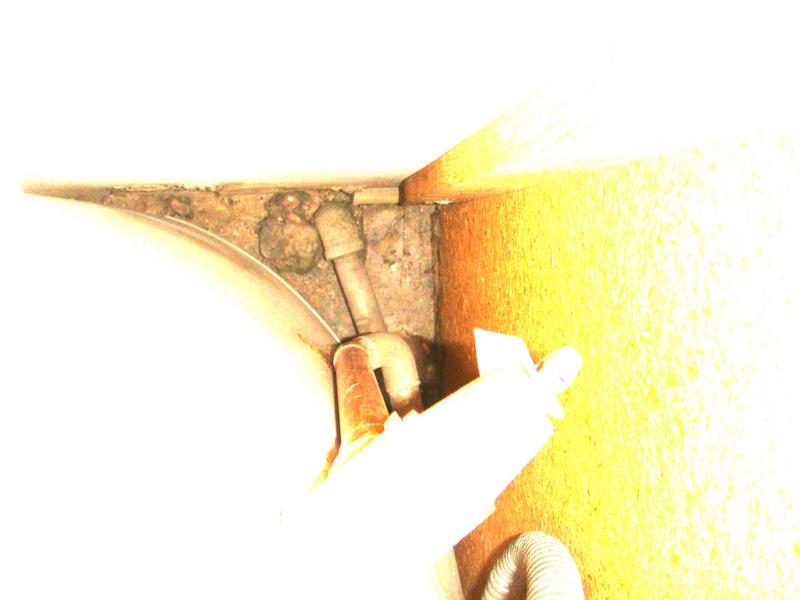belliott
December 31, 2008, 1:03am
21
Actualy I was thinking galv to copper .
jtribuzio
December 31, 2008, 1:05am
22
…if so needs the dielectric connector to prevent electrolysis corrosion.
jpope
December 31, 2008, 1:11am
24
I wouldn’t be concerned about that with this type of application. . .
belliott
December 31, 2008, 1:36am
25
True …as it is more of a concern on a water supply pipe,which is why I thought nothing of it when looking.
belliott
December 31, 2008, 1:42am
26
Here is a brightened picture of the other setup.
klott
December 31, 2008, 2:08am
27
One purpose for the air gap is to keep the end open where it can be noticed if the TPRV opens, to make the HO aware of a possible safety issue that needs to be looked at. BTW the IPC code allows the drain to end at the WH drain pan. MY Code Check book is out in the truck, else I would provide you with some numbers. If you don’t have them by tommorrow, I will send them to you. Also, if the WH is below grade, they need to install a Watts 210, because the pipe is not allowed to run uphill. You may want to inform them that a WH can build up pressure equal to 200 sticks of Dynamite and can obliterate a house and it’s contents, not to mention the occupants. I do not test the TPRV, but if you do, be aware that it sometimes will take up to 15 minutes to reseal properly.
mtimpani
December 31, 2008, 1:59pm
28
How about to the AC condensate line?
badair
December 31, 2008, 2:05pm
29
post 9 item 4 has the answer
mboyett
December 31, 2008, 2:39pm
30
Mark…read post #3 , especially the bold words. That is straight out of the IRC. So, no not even the a/c condensate can share the TPRV drain piping.
rmaday
January 2, 2009, 9:13pm
31
No. Needs to be on its own, to see if it’s discharging.
rmaday
January 2, 2009, 9:18pm
32
belliott
January 2, 2009, 10:26pm
33
The first link says 6" though that can be interpreted to minimum.
rmaday
January 2, 2009, 10:35pm
34
The first was directly related to TPRV, second for air gaps for cross connections.
Either way, Chicago is not necessarily Illinois. :shock:
Suprised the mayor hasn’t hit y’all up for a city fee for inspections. :twisted:
belliott
January 3, 2009, 12:27am
35
rmaday:
The first was directly related to TPRV, second for air gaps for cross connections.
Either way, Chicago is not necessarily Illinois. :shock:
Suprised the mayor hasn’t hit y’all up for a city fee for inspections. :twisted:
-X Sheeeeeesh…He might hear you.
tneyedli1
January 8, 2009, 1:37am
36
relliott:
**Thanks Jeff but that is not straight enough.
Not be directly connected to the drainage system.
Discharge through an air gap located in the same room as the water heater.
Not be smaller than the diameter of the outlet of the valve served and shall discharge full size to the air gap.
Serve a single relief device and shall not connect to piping serving any other relief device or equipment.
Discharge to the floor, to an indirect waste receptor or to the outdoors. Where discharging to the outdoors in areas subject to freezing, discharge piping shall be first piped to an indirect waste receptor through an air gap located in a conditioned area.
Discharge in a manner that does not cause personal injury or structural damage.
Discharge to a termination point that is readily observable by the building occupants.
Not be trapped.
Be installed so as to flow by gravity.
Not terminate more than 6 inches (152 mm) above the floor or waste receptor.
Not have a threaded connection at the end of such piping.
Not have valves or tee fittings.
Be constructed of those materials listed in Section 605.4 or materials tested, rated and approved for such use in accordance with ASME A112.4.1.
**Looks like #4 covers it and I wonder about #2 as it leaves me confused.
I would also note lack of a drain pan.
They have 2 heaters with one in the kitchen and one for the bathroom .
That just about says it all in one neat tidy package.
![]()

![100_2649 [800x600].JPG](https://global.discourse-cdn.com/internachi/original/3X/5/b/5bab316cff7615c3b574b5d977d0e8d3893949b5.jpeg)